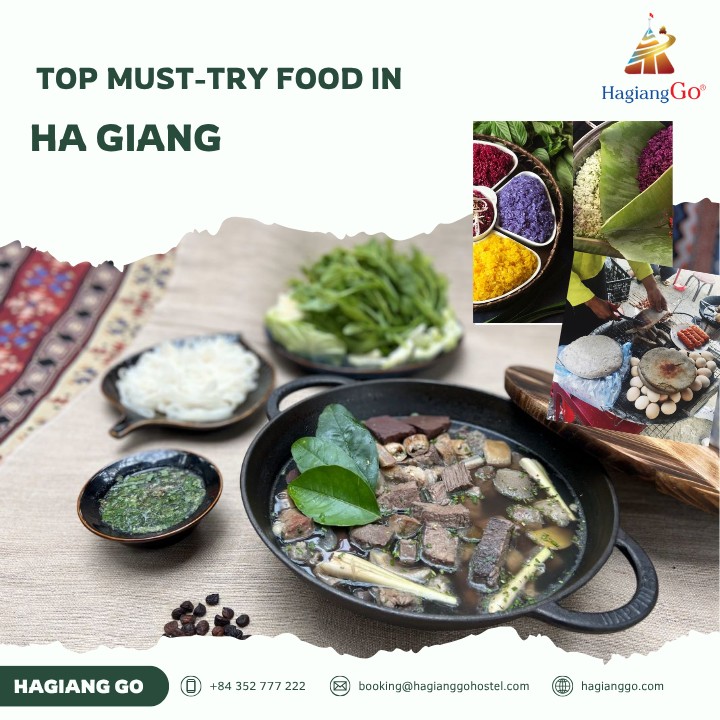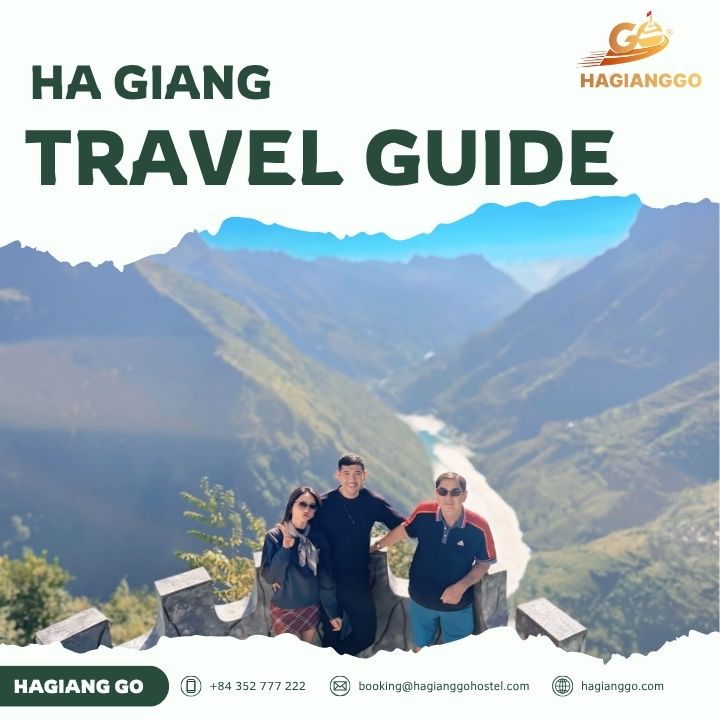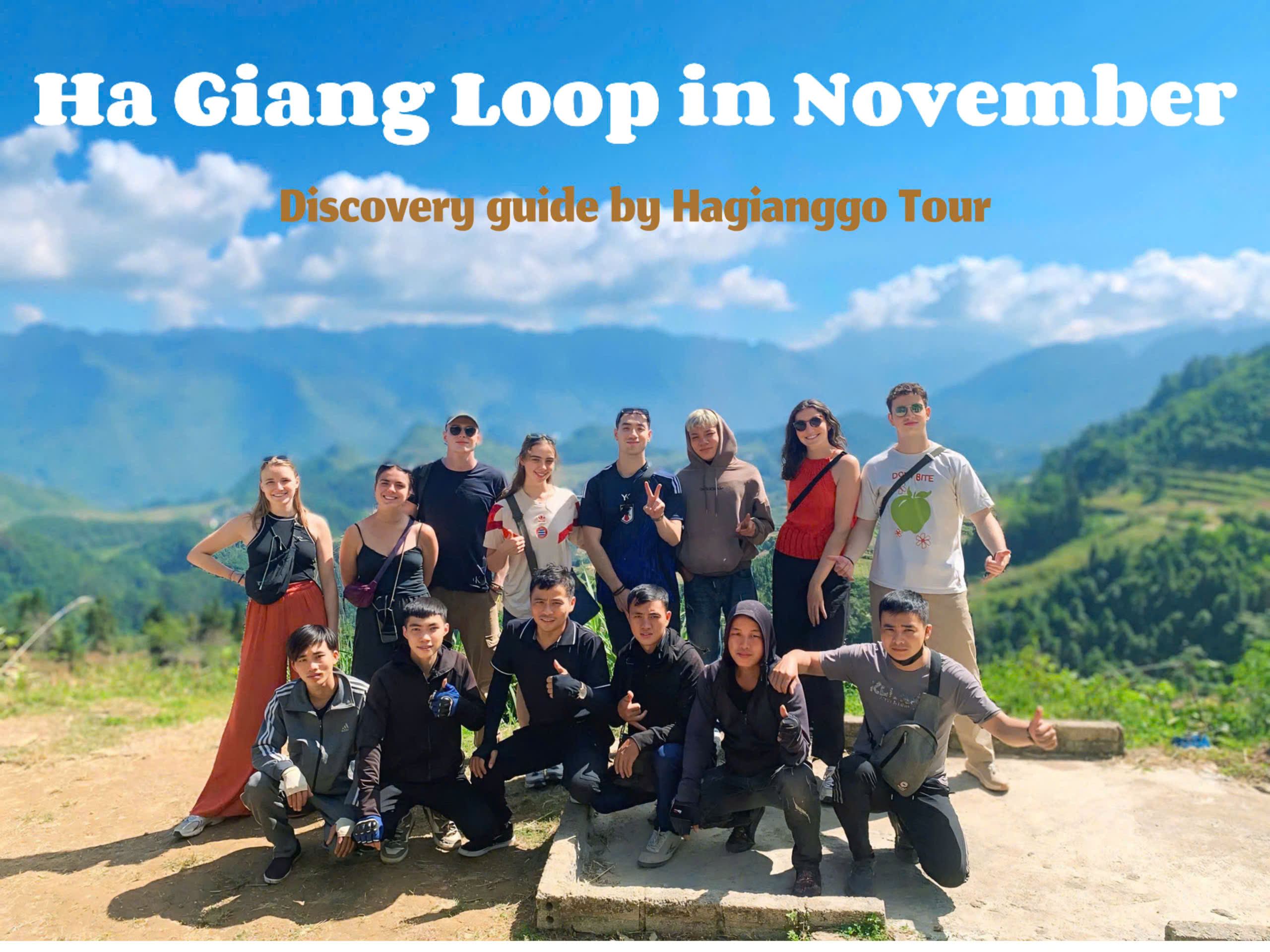1. Top 9 best food to try in Ha Giang
1.1. Thắng Cố (Horse Meat Hot Pot)
Thắng cố stands as Ha Giang's most famous and controversial dish. This traditional hot pot features horse meat as the main ingredient, typically served with fresh herbs, vegetables, and dipping sauces. The broth is clear and fragrant, simmered with bones and aromatic spices that create a surprisingly delicate flavor profile.
The horse meat itself has a distinctive taste – slightly sweet, lean, and more tender than beef when properly prepared. It's usually sliced thin and cooked briefly in the hot broth, similar to how you'd prepare beef in a hot pot. The dish comes with an array of fresh herbs, including cilantro, mint, and local mountain vegetables that help balance the rich meat flavor.
What to expect: The meat has a unique, slightly gamey flavor that's milder than you might anticipate. It's best enjoyed with the accompanying herbs and dipped in the traditional sauce made from fermented shrimp paste, chili, and lime.
Cultural note: While this dish may seem unusual to international visitors, it holds deep cultural significance for local ethnic communities, particularly the Hmong people, who consider horse meat a delicacy reserved for special occasions.

Thắng Cố is one of the weirdest in Vietnam - Source: Nhahangchotinhsapa
1.2. Phở Chua (Sour Pho)
Unlike the traditional Phở you know, Phở chua is served at room temperature and features a tangy, slightly sour broth that's incredibly refreshing, especially during warmer days in the mountains.
The special food of Ha Giang consists of fresh rice noodles topped with strips of pork, Vietnamese ham, and fried tofu. What makes it special is the clear, acidic broth infused with fermented rice and various local herbs. The sourness comes naturally from the fermentation process, creating a complex flavor that's both refreshing and satisfying.
Flavor profile: The broth offers a pleasant tartness that awakens your palate, while the combination of proteins provides substance. Fresh herbs and bean sprouts add crunch and freshness to each spoonful.
Eating tip: Mix all ingredients well before eating to ensure you get the full flavor combination in each bite. The dish is typically garnished with crispy fried shallots and fresh herbs that you can add according to your taste.
1.3. Thịt Trâu Gác Bếp (Kitchen-Dried Buffalo Meat)
Thịt trâu gác bếp is a traditional preservation method that transforms buffalo meat into a delicacy with intense, concentrated flavors. The meat is hung above traditional wood-burning stoves in local kitchens, where it slowly dries and absorbs the smoky aromas from daily cooking fires.
This preservation process can take several months, during which the meat develops a deep, dark color and becomes incredibly flavorful. The result is a chewy, jerky-like texture with complex smoky and slightly sweet notes. It's often served as an appetizer or snack, typically accompanied by sticky rice or local rice wine.
Texture and taste: The meat is quite chewy and requires thorough chewing, which releases layers of smoky, umami-rich flavors. It has a distinctive taste that combines the natural buffalo meat flavor with wood smoke.
Serving suggestion: It's traditionally enjoyed with a glass of local corn wine (ruou can) or green tea. The meat pairs wonderfully with steamed sticky rice or can be eaten on its own as a protein-rich snack.
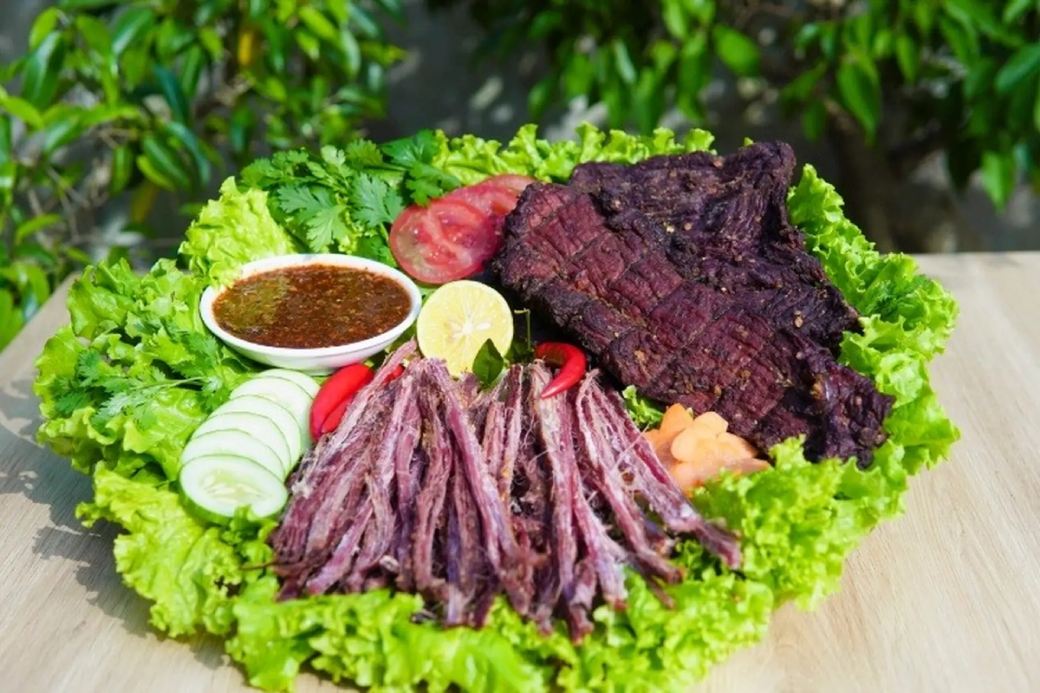
Thịt Trâu Gác Bếp is one of the best food in Ha Giang that you should not miss - Source: Fptshop
1.4. Bánh Tam Giác Mạch (Buckwheat Triangular Cake)
Bánh tam giác mạch showcases Ha Giang's abundant buckwheat harvest in a visually striking and delicious way. These triangular-shaped cakes are made from buckwheat flour, giving them a distinctive purple-gray color and nutty flavor that sets them apart from other Vietnamese rice-based cakes.
The cakes are typically filled with minced pork, mushrooms, and wood ear fungus, then wrapped in banana leaves and steamed. The buckwheat flour creates a slightly dense, chewy texture that's quite different from regular rice flour preparations. The filling is seasoned with local spices and provides a savory contrast to the nutty wrapper.
Unique characteristics: The buckwheat gives these cakes a hearty, almost earthy flavor with hints of nuttiness. The texture is more substantial than typical Vietnamese rice cakes, making them quite filling.
When to try: These cakes are seasonal, typically available during buckwheat harvest season (September to November). They're best enjoyed warm, and locals often serve them with a light dipping sauce made from soy sauce, chili, and herbs.
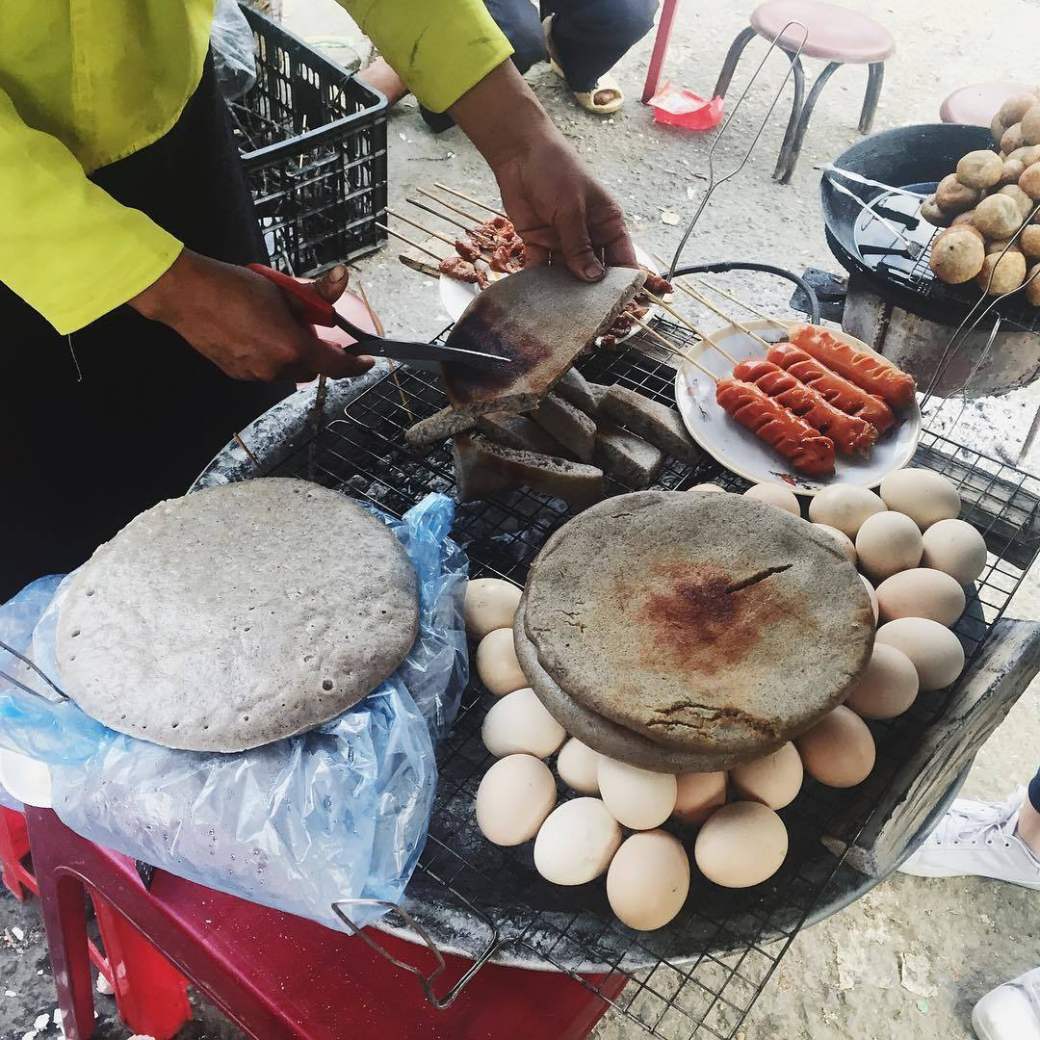
Source: Vietnamnet
1.5. Cháo Ấu Tẩu (Ẩu Tẩu Porridge)
Cháo ấu tẩu might sound intimidating, but this protein-rich porridge is considered a nutritious delicacy among local ethnic communities in Ha Giang. The dish features ant larvae harvested from specific ant species found in the region's forests, cooked into a creamy rice porridge with herbs and seasonings.
The ant larvae are tiny, white, and have a mild, slightly nutty flavor. They're rich in protein and considered highly nutritious by locals. The porridge itself is smooth and comforting, similar to other Vietnamese rice porridges, with the larvae adding protein and a unique textural element.
Flavor experience: The larvae themselves are quite mild and don't have a strong insect taste. The overall dish tastes like a well-seasoned rice porridge with small, protein-rich additions that provide a subtle crunch.
Nutritional note: This dish is valued for its high protein content and is traditionally given to children and elderly people for its nutritional benefits. It's typically seasoned with ginger, herbs, and sometimes a touch of fish sauce.
>>> See more: Where is Ha Giang Vietnam located?
1.6. Bánh Cuốn Phố Đồng Văn (Dong Van Steamed Rice Rolls)
The bánh cuốn from Dong Van town represents a regional variation of Vietnam's beloved steamed rice rolls. What sets the Dong Van version apart is the ultra-thin rice paper and the unique filling that incorporates local ingredients and preparation methods specific to the region.
These delicate rolls are filled with seasoned ground pork, minced wood ear mushrooms, and onions, then topped with crispy fried shallots and fresh herbs. The rice paper is steamed to perfection, creating an almost translucent wrapper that's incredibly soft and delicate.
Special qualities: Bánh cuốn Đồng Văn is notably thinner and more delicate than versions found elsewhere in Vietnam. The filling is more finely minced, creating a smoother texture that complements the delicate wrapper.
Serving style: They're served with a dipping sauce made from fish sauce, lime juice, chili, and sugar, along with fresh lettuce and herbs. The combination of textures and flavors creates a light yet satisfying meal.

Source: Checkintravel
1.7. Lạp Xưởng Hà Giang (Ha Giang Chinese Sausage)
Lạp xưởng represents the Chinese culinary influence in Ha Giang, reflecting the region's proximity to China and its diverse ethnic population. These sweet-savory sausages are made from pork and pork fat, seasoned with soy sauce, sugar, rice wine, and various spices, then air-dried to develop their characteristic flavor and texture.
The sausages have a firm, slightly chewy texture and a distinctive sweet-salty flavor profile. They're often darker in color than commercial versions due to traditional preparation methods and natural smoking processes. The fat content gives them a rich mouthfeel, while the seasoning provides complex flavors.
Flavor profile: These sausages are notably sweeter than Western sausages, with a complex umami depth from the soy sauce and fermentation process. The texture is firm but not dry, with small pieces of fat that add richness.
How it's served: Lạp xưởng can be eaten on its own as a snack, sliced and stir-fried with vegetables, or added to rice dishes and soups for extra flavor. It's often served during Tet (Vietnamese New Year) celebrations.
1.8. Xôi Ngũ Sắc (Five-Color Sticky Rice)
Xôi ngũ sắc is perhaps Ha Giang's most photogenic dish, featuring sticky rice in five vibrant colors that represent the five elements in traditional Vietnamese philosophy. This colorful creation uses natural ingredients to achieve its stunning rainbow appearance.
Each color comes from different natural sources: purple from butterfly pea flowers or purple sticky rice, yellow from turmeric, red from gac fruit, green from pandan leaves, and white remains the natural rice color. The rice is steamed separately for each color, then combined to create beautiful, layered presentations.
Taste and texture: Despite the different colors, the flavors are subtle and don't dramatically alter the natural sticky rice taste. Each color may have slight flavor variations – the turmeric adds earthiness, pandan contributes a subtle sweetness, and gac provides mild fruitiness.
Cultural significance: This dish is often prepared for special occasions and festivals. It's not just food but also an art form that demonstrates the cook's skill and creativity. The colors are believed to bring good luck and prosperity.
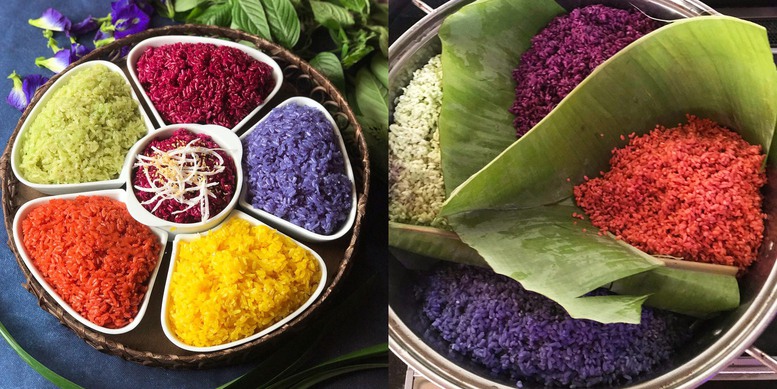
Source: Baochinhphu
1.9. Cơm Lam Bắc Mê (Bac Me Bamboo Rice)
Cơm lam from Bac Me district showcases an ancient cooking method where rice is cooked inside bamboo tubes over an open fire. This technique imparts a subtle bamboo fragrance to the rice while creating a unique texture that's both tender and slightly firm.
The rice is mixed with coconut milk and sometimes beans or corn before being sealed in bamboo tubes and roasted over charcoal. The bamboo acts as a natural steamer and flavor enhancer, giving the rice a distinctive aroma and taste that can't be replicated through conventional cooking methods.
Unique characteristics: The bamboo cooking process creates rice with a subtle woody fragrance and a slightly sticky texture. The coconut milk adds richness and a hint of sweetness, while the bamboo tube creates an attractive presentation.
Serving tradition: The bamboo tube is split open at the table, revealing the perfectly cooked rice inside. It's often served with grilled meats or vegetables and is considered both a cooking method and a serving vessel.
1.10. Rượu Ngô (Corn Wine)
Corn wine represents far more than just an alcoholic beverage in Ha Giang's stone plateau region; it embodies the cultural soul and agricultural heritage of the highland communities. This indigenous drink, crafted from locally grown corn and traditional leaf yeast, produces a distinctive, slightly smoky aroma that gives way to a remarkably smooth, sweet flavor without the harsh bite typical of stronger spirits.
With an alcohol content of 25-30%, the golden-hued wine offers a warming sensation perfect for the cool mountain climate. You'll find it sold directly at local markets such as Khau Vai market, where vendors, primarily women, display rows of 10 to 20-liter containers, measuring portions with traditional cups. The corn used is harvested in April and carefully dried by hanging from house rafters to prevent moisture and pests. When enjoying corn wine, sip it slowly to appreciate its complex sweetness and aromatic qualities.
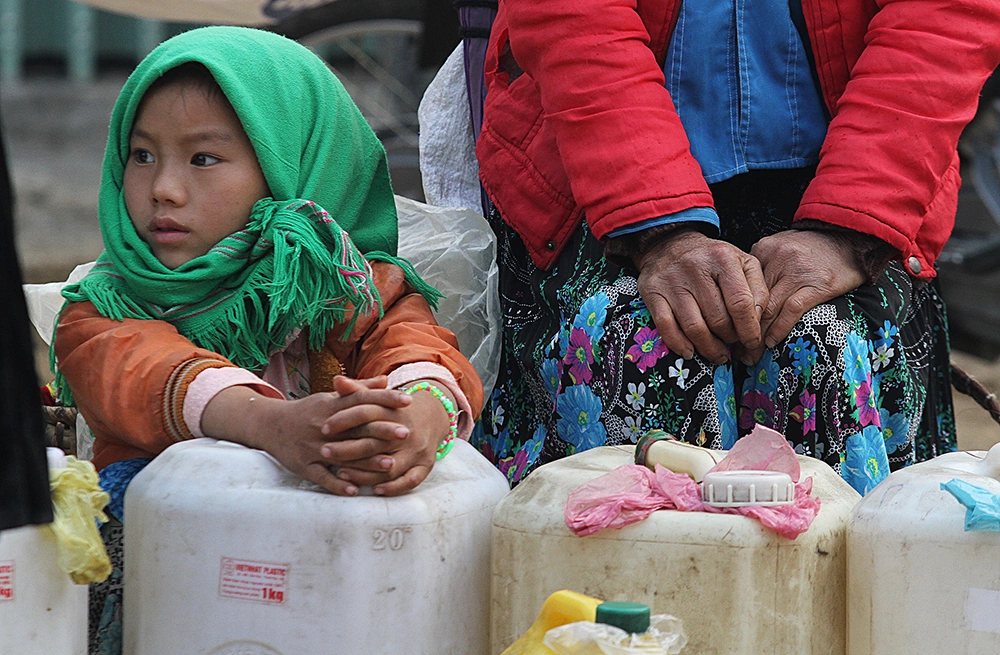
Local people selling Rượu Ngô in the market - Source: Vnexpress
1.11. Hồng Không Hạt (Seedless Persimmons)
The seedless persimmons of Quan Ba district stand as Ha Giang's crown jewel among fruits, distinguished by their vibrant golden-yellow skin when ripe and exceptionally crisp texture that sets them apart from persimmons found elsewhere in Vietnam. These large, powder-soft fruits deliver an intensely sweet flavor without any astringency or hardness, complemented by a unique mountain fragrance that reflects their high-altitude origins. Cultivated by ethnic minorities, including the Hmong, Dao, Tay, and Lo Lo people, using traditional methods, these persimmons thrive in Quan Ba's ideal conditions—elevations above 1,000 meters, fertile soil, and clean water sources.
The fruit's remarkable quality comes from a special soaking process: after harvesting from August to November, locals submerge the persimmons in clean water for 3-4 days to remove natural tannins and enhance their sweetness. When visiting during harvest season (September-November), you can experience picking these delicate fruits yourself, but remember to learn proper techniques from local farmers—timing is crucial, and freshly picked persimmons must be immediately soaked to achieve their signature sweet taste.
1.12. Bánh Chưng Gù (Hunchback Sticky Rice Cake)
Bánh chưng gù presents a fascinating culinary art form unique to the Tay ethnic community of Ha Giang, instantly recognizable by its distinctive curved shape that resembles a woman carrying a traditional back-basket. This ceremonial cake features layers of glutinous rice in appealing natural colors, encasing a rich filling of black pork and mung beans, all wrapped carefully in aromatic dong leaves that impart their signature earthy fragrance. The preparation requires exceptional skill - after wrapping, the cakes are boiled for 8-10 hours over steady heat with constant water levels to ensure even cooking without burning.
When properly prepared, the cake reveals a beautiful color palette when unwrapped, combining the fragrant sweetness of sticky rice with the rich, fatty flavor of local black pork and the nutty taste of mung beans. The compact size makes it perfect for travelers to carry and enjoy on the go. The texture is remarkably tender and satisfying without being heavy or cloying, making it an ideal representation of Tay culinary craftsmanship and an essential taste experience for any visitor to Ha Giang's highlands.

Source: Hagiang.gov
2. Tips for food adventurers in Ha Giang
Seasonal considerations: Many Ha Giang specialties are seasonal. Buckwheat products are best during harvest season (September-November), while certain mountain vegetables and herbs are only available at specific times of the year.
Where to eat: Local markets, family-run restaurants, and homestays often offer the most authentic experiences. Don't hesitate to try street food - it's usually fresh and prepared according to traditional methods.
Dietary accommodations: While Ha Giang cuisine is meat-heavy, vegetarian options exist, particularly dishes featuring mountain vegetables, sticky rice, and tofu preparations. However, inform your hosts about dietary restrictions in advance.
Food safety: Stick to busy establishments with high turnover, ensure meat is well-cooked, and drink bottled or properly boiled water. Most local food is safe, but take standard travel precautions.
Cultural respect: Some dishes like thắng cố may seem unusual, but approach them with an open mind and respect for local traditions. These foods have cultural significance beyond mere sustenance.
Ha Giang's cuisine offers a window into the region's soul – rugged, diverse, and deeply connected to the land.

Dong Van ancient market is one of the best places to enjoy Ha Giang food - Source: Baohagiang
Each of the Ha Giang food above tells a story of adaptation, tradition, and the creativity of mountain communities. Whether you're sampling the controversial thắng cố or enjoying the colorful xôi ngũ sắc, you're participating in culinary traditions that have sustained communities for generations. Embrace the adventure, respect the culture, and prepare for flavors you won't find anywhere else in Vietnam.
